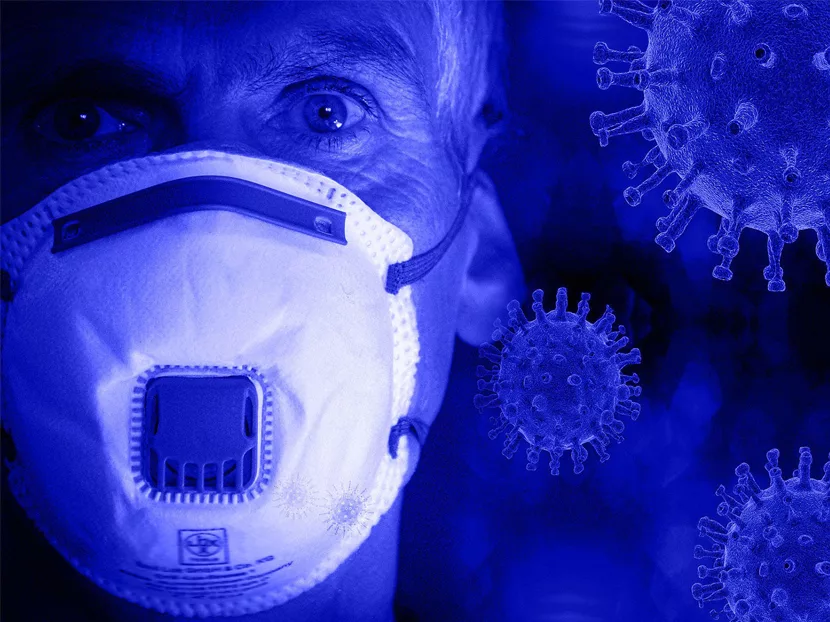Necessity is the mother of invention; the triple whammy of COVID-19, a recession and climate change are creating more necessity than ever before. Numerous laboratory and real-world solutions are coming forward to address the challenges we face in ventilation, cooling, stresses on our food system, and resilience for the changing ways we use our homes and business buildings.
UVC Light for Disinfection
Dr. Ali Nouri, president of the Federation of American Scientists in Washington, D.C., reports that colleagues at Japan’s Hiroshima University confirmed a finding our industry was hoping for — that far-UVC light inactivates the novel coronavirus that causes COVID-19 in a few seconds. The study has been published in both the American Journal of Infection Controland on the U.S. National Library of Medicine website.
This is good news because it confirms that UV light can kill this particular virus, as it has with SARS and MERS coronaviruses before it. It’s even better because far-UVC light is different than the usual UVC light. Low doses of far-UVC light are considered safe for humans while killing the virus, so it can be used for disinfecting indoor spaces, even with people in the room.
However, scientists and leaders in our industry, such as ASHRAE officials, are not overly excited — and for good reason. Although specific Internet videos from Asia have shown blue light being used in rooms with people, it may not be effective or safe.
First of all, if it is UVC light in the video, it likely is not far-UVC light, and it may be dangerous to human skin, eyes and so on. Second, these are lab results. The Japanese study only investigated in vitro efficacy; no credible scientific reports were published on the technology succeeding in a real-world setting.
Following the announcement, Gennady Simanovsky, CEO of Dolphin Vision, a global supplier and manufacturer of UVC technology, stated: “There are no UV ‘safe’ light solutions that could come soon, let's say in resolution of one to two years. Research about safe UV [has been] done for years, [and we’re] still far from an engineering solution.”
Dolphin develops UVC systems for airplanes and other transportation applications, buildings, elevators and so on. The company says that its systems “effectively deactivate 90 to 99 percent of micro-organisms,” such as bacteria and viruses, including COVID-19.
Humans cannot be safely exposed to the UVC light while Dolphin disinfection systems are being applied. Similar to the COVID-19 vaccine most of us are wishing for, real-world safe-for-humans blue light disinfection may take some time.
Cooling System Works with Open Windows
Speaking of lab results, researchers from Princeton University, the University of California-Berkeley, University of British Columbia, and a Swiss research lab in Singapore developed what may be a ground-breaking new cooling technology. The new approach, called Cold Tube AC, could be relevant during pandemics because it provides a low energy cooling effect in semi-outdoor or high ventilation conditions. Despite the name, it’s a kind of radiant effect that doesn’t actually cool the air.
In this case, however, the product is much closer to commercialization. The development team published a paper in the PNAS journal (U.S. National Academy of Sciences) and built a demonstration unit last year in Singapore.
“Because the Cold Tube can make people feel cool without dehumidifying the air around them, we can look toward shaving off up to 50 percent of typical air conditioning energy consumption in applicable spaces,” says Eric Teitelbaum, senior engineer at AIL Research and a member of the team, in a SciTechDaily report.
The team says the technology is ready for commercialization for semi-outdoor applications such as bus stops, public markets, outdoor restaurants and concerts, and designs are being finalized for indoor air-conditioning applications even on hot days with windows open.
The paper explains that cooling down and dehumidifying the air around us is an expensive and not a particularly environment-friendly proposition. Instead, this system absorbs heat emitted by radiation from a person and creates the sensation of cooling, even if the air temperature is high. Dozens of demonstration subjects reported feeling “cool” or “comfortable,” despite an average outdoor air temperature of 86 F.
The system consists of a rectangular wall and ceiling panels with chilled water circulating within them. When a person stands near a panel, his or her body heat radiates toward it. Panels also remained condensate-free and dry during the Singapore event, thanks to the use of a special membrane selected for this purpose.
Agriculture Using Seawater
An unsung technology solution for growing food is already commercialized and boasts about a decade of successful operation — doing, in harsh conditions, what many people thought was impossible. Seawater Greenhouse is a UK company operating “greenhouses” near saltwater oceans in desert locations in Australia, the Middle East and Africa. Vegetables are grown using desalinated water; the company is now selling large volumes of produce.
It was considered impossible because desalination has traditionally been very expensive, suggesting that such an operation would be economically uncompetitive compared with traditional agriculture. But some relatively low-tech innovations have changed the validity of these assumptions.
The structures the company builds are not greenhouses in the usual sense. They’re made mostly of canvas and cardboard, rather than glass. They use 50-year-old pad and fan technology. Aspen or cellulose pads are mounted in the sidewalls of the structures. They’re supplied with water from a pipe above the pads. Fans or outdoor wind push air through the water-soaked, corrugated, vertically hung layers of cardboard, dropping the temperature by around 15 C. The cooler, moist microclimate means plants require less fresh water and less irrigation, thereby reducing water usage and overall costs.
Evaporative cooling — changing water from liquid to vapor — is very efficient because it absorbs considerable heat. It takes 1 BTU of heat to raise the temperature of 1 pound of water 1 F, but it takes 1,060 BTUs of heat to change the same amount of water to a vapor. In other words, for each gallon of water evaporated naturally, about 8,700 BTUs of heat are absorbed.
As water is pushed through the pad, the salt is separated from the freshwater, creating a more effective brine for evaporative cooling. It has a higher boiling point and lower freezing point than pure water, which means it works better as a coolant.
As it condenses, the desalinated fresh water irrigates the crops, revegetates the surrounding landscape outside the greenhouse and provides clean drinking water. Leftover salty brine is made into salt. In the future, the company may sell lithium, cobalt and magnesium because they’re also efficiently extracted by the process.
Portable Batteries for the Jobsite
New products have been flying onto the market related to small solar cells and batteries in the last few years. Each time the cost of these drops or the efficiencies increase, new applications can make sense. Suppose you want to ditch the carbon-spewing generator for your temporary jobsite’s power needs. In that case, a few companies are now offering batteries on trailers with fold-out solar arrays attached to the top of them.
Others offer different types of portable batteries alone for a variety of personal, commercial or industrial uses. For example, Hybrid Power Solutions offers several products for sale or rent with capacities ranging from 2.5 kilowatt-hours to 3.6 kilowatt-hours for applications that might require 4,000 watts of continuous power or surge power up to 8,000 watts.
If the COVID-19 recovery advances, you may be able to reserve their products on short notice from big-box stores such as Home Depot or Lowes.
Bill Pollock, a sales agent with the company, says these power systems are used for mining, construction and roadside assistance charging for electric vehicles. He points out that designers selected lithium-iron-phosphate prismatic batteries, rather than the more popularized lithium-ion technology because the former is price-competitive and allows for somewhat greater safety. For example, there are restrictions on lithium-ion when it’s shipped by air, and it might not be a great choice down in a mine where a fire could be catastrophic.
The 3.6-kWh product is small enough to shove into the hatchback of an ordinary car. The company also offers a heavier, less portable product called the Battpack Jupiter that must be moved around the jobsite like a wheelbarrow. It can provide 7,000 watts of continuous power and 12,000 watts of surge power at 240 volts. Some of the company’s products can be combined with additional expansion packs as well. They may be applicable in situations involving temporary power to buildings, and even micro-grids and small solar arrays.
Micro-Grids for Resilience
The pandemic and rising cybercrime have caused many homeowners and business people to think more about ways to go off-grid. We want to create residences, businesses, campuses or communities that can be disconnected from power infrastructure or the broader Internet during disasters or emergencies and still function.
As I write this, wildfires are raging in 12 states, notably perhaps in California. Floods are ravaging the East Coast, and snow is falling in Colorado — in September. Greater interest in resilience within extreme climate change scenarios translates into more designs for microgrid power systems and islanded entities of different descriptions.
The Redwood Coast Airport Renewable Energy Microgrid in northern California covers seven acres and connects multiple nonadjacent customers. The anchor tenants are the regional airport and a U.S. Coast Guard air station. Its “front-of-the-meter” design enables the output from the grid-tied solar capacity to be redirected to the microgrid in island mode, meaning that along with backup batteries, the airport and Coast Guard facilities can effectively operate indefinitely as critical lifelines for the community.
This is unique because in most places in the United States, if a private microgrid is proposed that would pass over a public road or public land, a regulated utility is required as a partner. In this case, Pacific Gas & Electric will own and operate the microgrid equipment and oversee its operation in island mode whenever the regional grid is inoperable, or the utility implements a public safety power shutoff. Outages are a frequent occurrence in the area due to forest fires and other problems.
Smart Money Sticks with Microgrids
Microgrids, batteries, the electrification of HVAC systems, and smart home technology together represent a disruption in our industry and business opportunities. They can significantly change the way we design, build and service homes and business buildings. They also represent the blurring of the lines between the 20th-century concept of our electricity being generated centrally and distributed to us by utilities, and the ability to self-generate.
During August, some substantial investments were announced that suggest prognosticators like me are not alone in seeing value, profits, jobs — a business case for the proliferation of private microgrids. French energy automation giant Schneider Electric formed a partnership with San Francisco’s Huck Capital and Dubai’s Inclusive Capital Partners to create a special marketing arm to pursue microgrid business in North America and beyond.
In September, Siemens announced the creation of a “living lab” at its headquarters in Princeton, N.J. Researchers will study solar photovoltaics, battery storage, electrical power infrastructure, building management systems and microgrid control systems to develop a blueprint for universities, office parks, industrial sites and commercial operations.
“The notion of the electric grid as we know it is probably going to fade away,” says Schneider’s Chief Innovation Officer Emmanuel Lagarrigue in a Financial Post/Bloomberg news interview. “You can now imagine a world in the future where every home, hospital, shopping mall is purchasing its own energy, storing it and eventually exchanging it with others.”
He points out that Google and Facebook created their own renewables facilities or signed power purchase agreements. But a need exists for options for smaller companies to enjoy the advantages of clean energy micro-grids, such as peak energy savings, disaster resilience and healthier, smarter buildings.
“Microgrids continue to become an integral part of our modern-day energy systems because they not only provide an answer to threats like extreme weather and power outages, but will also play a significant role in helping cities and communities meet their challenging CO2 reduction targets,” notes Dave Hopping, president and CEO of Siemens Smart Infrastructure North America, on microgridknowledge.com.
Sometimes it seems as if our problems keep getting worse and there’s no way to fix them. But we must try. In the past when we have focussed on thinking creatively and valuing human ingenuity, we have, to some extent, succeeded and made the necessary changes to our approaches. Electrified HVAC, different battery, smart home and independent microgrid technologies, smarter food systems, convenient virus disinfection and cooling systems that work with the windows open — all are necessary responses to a world full of crazy.
Necessity is more than the mother of invention. It’s an explosion of innovation. Let’s keep it going.






